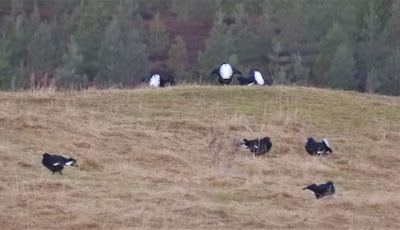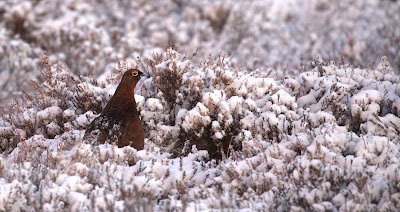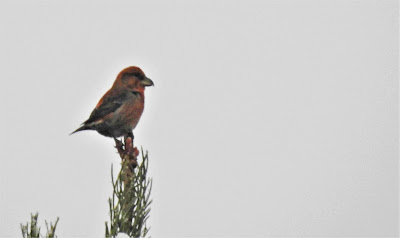January 2023
The first 3 weeks of January 2023 saw us 'enjoy' weather more akin to Narnia than Nairn!, with regular heavy snow and temperatures down to -10c creating a world in white, and turning the Cairngorms National Park into a real 'winter wonderland'.
Thankfully, the excellent all-weather ability of my trusty 4-wheel drive Land Rover Discovery allowed us to access most of my favourite sites without too much difficulty, and on the plus side, the spectacular snowy scenery was a sight to behold, giving ample scenic landscape photo opportunities.
The last week of the month, rather unusually, saw the weather turn unseasonably mild, with Atlantic lows dominating, temperatures way above average and lots of grey cloudy days, and all the snow at lower levels rapidly melted.
The days are lengthening noticeably now, with up to 8-9 hours of usable daylight, and dawn (for the Black Grouse) is still a relatively sociable 8am, with dusk at around 5pm.
Full-day local safari bird lists usually top-out in the 30's or 40's, though a trip to the nearby (one hour by car ) Moray Coast can boost this total considerably, whilst mammal day lists can vary between 3 and 8 species, depending on the time of our start and number of habitats visited, with early starts usually proving to be best.
 |
| A picturesque midwinter scene at a local loch |
To give you an idea of what you may realistically hope to see if you are considering a future January visit, I hope the following more detailed information, illustrated with photos taken at sites in and around the Cairngorms National Park, and sometimes further afield, by myself, my friends or my safari clients this month and in previous January's will help....clicking on the picture enlarges it to full-screen.
Local speciality/upland bird species seen regularly during the month included:
Crested Tit, Red Grouse, Golden Eagle and Dipper, whilst Black Grouse were occasionally seen at or soon after dawn at traditional lek sites, and we also had a few decent sightings of Golden Eagle and a couple of views of White-Tailed Eagle.
Local winter visiting birds were represented by Redwings and Fieldfares, family groups of Whooper Swans, several species of 'grey' Geese, and a few Redpolls were spotted...and a few Waxwings were seen locally for the first week, though Bramblings seem to be very few and far between this winter....
Mammal species seen regularly included:
Red Squirrel, Red Deer, Reindeer, Roe Deer, Mountain Goat , Rabbit and (white) Mountain Hare.....with just a couple of (mainly dawn) views of Brown Hare , and a few brief glimpses of Bank Vole underneath bird feeders....
January 2023 bird sightings in more detail:
Up in the glens...
 |
| A local upland glen |
 |
| Golden Eagle |
 |
| Golden Eagle by Bob Smith (Photo from Jan 2022) |
 |
| White-Tailed Eagle with Common Buzzard |
Although sightings of Eagles were a little less frequent when compared to the usual annual peak viewing time of October-December, both Golden Eagle and White-Tailed Eagle were seen several times in favoured local glens this month. It was great to get my 'year-tick' of both of these iconic and awesomely impressive birds by mid-month, and although most views were at some distance, we got really lucky on the 18th, when an adult White-Tailed Eagle had a mid-air duel with a Common Buzzard at quite low altitude, giving sensational close-up views, and even a rare photo opportunity - a truly magical moment!
 |
| Red Kite |
 |
| Ring-Tail Hen Harrier |
 |
| Kestrel |
 |
| Male Sparrowhawk (photo from Jan 2019) |
The regular 'raptor back-up cast' of Kestrel, Sparrowhawk, Buzzard , Red Kite, and even the occasional Hen Harrier should not be forgotten though, as all were seen and enjoyed at least once this month, though Goshawk, Merlin and Peregrine have still yet to be encountered on my safaris this year...
Up on the moors....
 |
| A local upland heather moorland |
 |
| Displaying Black Grouse at dawn on a local upland moorland |
 |
| Displaying Black Grouse by Karen Weissmann |
Black Grouse are one of my favourite local speciality birds, and always prove popular with my safari clients, especially from January to May when they usually display and lek at dawn. However, our early morning visits to their traditional 'lek' sites gave 'patchy' results this month, with a few 'no shows' offset by up to 8 cock birds showing beautifully on one occasion...please be aware though, that they are easily 'spooked' and are legally protected from disturbance, so we have to keep a respectable (and lawful) distance away...
 |
| Male Red Grouse by Karen Weissmann |
 |
| Male Red Grouse |
Still on the moors, the Red Grouse are becoming a little easier to see each week now, as the cock birds become ever bolder, often posturing aggressively from a raised position, and calling 'go-bak, go- bak' loudly to establish a territory and attract a mate, often with their red 'eyebrows' bulging impressively.
In the forests...
 |
| A local ancient Caledonian forest |
 |
| Crested Tit by Bob Smith |
 |
| Crested Tit by Bob Smith |
In the Caledonian pine forests, our local Crested Tits occasionally showed well at my favourite forest feeding stations, especially soon after dawn, and particularly on the colder days, when they are presumably at their most desperate for food, with up to 2 of these true 'local specialities' showing at once...with several of my delighted safari clients seeing them for the first time, and we even managed a few decent photos.
It is well worth noting that the winter months (October-February) are actually the best time of year for seeing the 'wee Cresties', as these characterful little birds can be frustratingly secretive and unobtrusive during the breeding season, with sightings being much more difficult to obtain between March and September....
 |
| Male Crossbill (photo from January 2021) |
Crossbills however, proved to be frustratingly elusive this month, with sightings largely restricted to fly-overs, and only a couple of very brief opportunities to see perched or feeding birds....
 |
| Capercaillie poo |
Sadly, despite many hours spent and miles walked in search of a Capercaillie this month, not a single sighting was achieved, though I did find the odd distinctive cigarette shaped poo formed mainly of pine needles, to give me a little encouragement to continue my quest...
Please note that Capercaillie numbers would still appear to be declining alarmingly, they are now very rare and elusive, and I would only rate our chances of seeing one on my safaris as "very slim" at best...
On the rivers...
 |
| An icy local river |
 |
| Dipper by Bob Smith (photo from Jan 2020) |
 |
| Dipper |
Our local Dippers are now most definitely in territorial mode, and we were lucky enough to see them posturing and displaying and sometimes singing their distinctive 'scratchy' song from a prominent rock on several occasions, often near a bridge, where they are likely to nest...
On the lochs...
 |
| Midwinter at a local loch |
 |
| Drake Goldeneye |
Though they were frozen and almost devoid of birds for the first 3 weeks of the month, star birds on the lochs during the winter are probably Goldeneyes, with the males now in their dapper breeding plumage, and some even seen performing their elaborate 'head-banging' courtship displays, and the winter-visiting Whooper Swans, with a back up cast of Goosander, Teal, Wigeon and Tufted Ducks.
Up in the mountains....
 |
| A wintry scene in the Cairngorm Mountains |
 |
| Snow Buntings |
 |
| Snow Bunting by Bob Smith |
 |
| Snow Bunting by Karen Weissmann |
Snow Buntings can usually be seen at slightly lower levels in the winter months, and that was the case for most of the month, as the heavy snowfall persuaded them down from the inhospitable mountain tops, and we enjoyed some good views of these attractive and endearing little birds.
With the Cairngorm Funicular Railway still closed for major repairs until it finally reopened near the end of the month, and the days so short now, I didn't venture up into the mountain-tops myself this month, but for future reference, a few Ptarmigan , still totally white, can sometimes be seen, up around the 'snow-line', usually sheltering in corries or on the leeward sides of ridges, out of the cold wind...
Winter-visiting birds seen in our area this month included:
 |
| Whooper Swans |
 |
| Lesser Redpoll by Bob Smith |
 |
| Fieldfare |
 |
| Waxwings |
 |
| Waxwings |
 |
| Waxwings |
Other good/scarce birds seen/reported locally this month included:
A Marsh Harrier all month, a few sightings of White-Fronted Geese, and one of a Jack Snipe, all at Insh Marshes, a few Twites and Bramblings on local farmland, Tree Sparrows at a Nethybridge feeding station, and an Iceland Gull at Boat of Garten.....
A few photos of more common birds seen locally this month:
 |
| Male Bullfinch |
 |
| Female Blackbird |
 |
| Song Thrush |
 |
| Male Chaffinch |
 |
| Robin |
 |
| Great Tit and Coal Tit by Karen Weissmann |
 |
| Greylag Geese by Karen Weissmann |
 |
| Red-Legged Partridge by Karen Weissman |
 |
| Male Pheasant by Karen Weissmann |
Adventures 'out of area':
 |
| Hopeman Bay on the Moray Coast |
 |
| Cormorants, Shags, and a Greater-Black Backed Gull |
 |
| Sanderlings |
 |
| Ringed Plovers |
 |
| Red-Breasted Merganser |
 |
| Eiders |
 |
| Black-Tailed Godwit |
 |
| Eurasian Teal |
 |
| Green-Winged Teal |
 |
| Iceland Gull and Eurasian Wigeon |
 |
| Grey Partridges at dawn by Bob Smith |
 |
| Tree Sparrows |
 |
| Yellowhammer |
The Moray coast is only about an hour drive north of Aviemore, and trips to favourite reserves, lochs, bays and harbours gave good views of wintering birds such as Greylag Geese, Pink-Footed Geese, Whooper Swan, Shoveler, Wigeon, Teal, Pintail, Black-Tailed Godwit, Knot, Golden Plover , Grey Plover , Ringed Plover, Purple Sandpiper, Redshank, Oystercatcher, Turnstone, Curlew, Common Scoter, Long-Tailed Ducks, Eiders, Divers, and Slavonian Grebe, with the chance of scarce birds such as Tree Sparrow and Grey Partridge, and rarities such as Snow Geese, rare Scoters, rare gulls, and King Eider.....
January 2023 mammal sightings in more detail:
Mountain Hare (photo from Jan 2017) 
Mountain Hare by Steve Nicklin (photo from Jan 2018)
Star mammal for January is usually that much sought-after local speciality the Mountain Hare, and rightly so, as Britain's only native 'lagomorph' and with their UK distribution being restricted to just a few remote upland areas, seeing one is always a treat.
Seeing them was actually easier said than done for much of the month though, with the heavy snow making the job of finding a white animal on a white background pretty tricky, with following their pawprints in the snow proving to be the best method. of finding them...
It should be noted though, that most of our views are at range through my telescope, and that a closer view or photo opportunity usually involves some considerable rough uphill walking, often in deep snow....
 |
| Red Deer hinds |
 |
| Red Deer stags |
In the same upland glens, Red Deer, mainly in large same-sex herds, can usually be seen, although a number of factors such as the weather, in particular the wind strength and depth of the snow, and whether there is any local shooting activity , can dictate whether we get nice close-up views, or distant views through the telescope....

Feral Mountain Goats (photo from Jan 2020)
Still up in the glens, another local speciality mammal, our Feral Mountain Goats can often seen on the same sheltered sides of the ridges as the Red Deer , and at this time of year it is not unusual to see them with the first , very cute, new-born youngsters ....

Red Squirrel by Caterina Mazzocchi
Red Squirrels are a true Highlands speciality, and we are usually fortunate enough to see at least one on most of my safaris, mainly chomping on peanuts at forest feeding stations, but with the occasional random sighting whilst walking or driving in suitable habitat.
Roe Deer by Steve Nicklin (photo from Jan 2020)
Roe Deer are most commonly seen at dawn or dusk and generally at the quieter, more remote sites well away from human disturbance, their shy, nervous nature making them much harder to see than Red Deer, despite being considerably more numerous and widespread than their larger 'cousins'...
Although we managed a few early morning sightings of Brown Hare this month, mainly on the quieter farmland areas, they were very fleeting glimpses, and sadly, I failed to get a decent photo ...

Carrot time for Murdo means smiles all round...
Hairy Highland Coo's always prove to be popular with my safari clients, especially those who do not have them close to home, so don't be afraid to ask me if you fancy going to see them, and maybe even get to feed and 'pat' them, as I have a couple of great sites....
Rare/nocturnal mammals:
I get a few enquiries about the possibility of seeing Badgers and Pine Marten from my safari clients, many of whom I suspect are unaware that they are actually a largely nocturnal creature, and although we do get the occasional (maybe one or two a year) dawn glimpse of one, you would definitely have a much higher chance of seeing them at a specific dusk Badger/Pine Marten watching hide - Please contact me for more information.
Similarly, our inland Otters too are mainly active during the hours of darkness, and again, although we do get a few early-morning sightings on local lochs and rivers each year, looking for them feeding in a suitably quiet, kelp - filled bay on the coast on a rising tide, but at any time of day, would give you a much better chance.
Whilst we are still on the 'tricky to see stuff', the Scottish Wildcat too, as well as being incredibly rare now, is also generally nocturnal, and the fact that I have had a mere handful of (dawn or dusk) sightings in 17 years of providing wildlife safaris should give you an idea of how difficult they are to see.
Other wildlife:
Nothing to report in this category this month, I'm afraid....
News:
All tourism/hospitality/activities in Scotland are open , are free of restrictions and I have now completed well over a year of (thankfully!) increasingly busy and extremely enjoyable safaris with clients with no major issues arising.
With all national travel restrictions lifted too, Scotland is officially 'open for business' for visitors from all over the UK, and from abroad.
For those considering a visit, these wildlife/outdoor tourism websites may prove useful:
https://www.gov.scot/collections/coronavirus-covid
NatureScot (outdooraccess-scotland.scot)
Can Nature Help Health? | Nature Prescriptions - YouTube
Scotland, Yours to Enjoy. Responsibly. - YouTube
Cairngorms National Park Authority
Positive prescriptions | The RSPB
 |
| A snowy scene at Insh Marshes RSPB Reserve |
COVID-19
The Scottish Highlands, being very sparsely populated, has had very few COVID-19 cases in comparison to most of the UK, and on my safaris we tend to visit remote , wild habitats well away from the more popular tourist areas, and usually have very little interaction with other people, and this is something that I intend to continue.
 |
| Thank goodness for 4-wheel drive! |
Summary:
Reviews:
Photos:
Prints of any of the photos (taken by myself) shown on this blog, going right back to 2015, reproduced on high quality photographic paper, with a choice of sizes up to A3, and satin pearl or glossy finishes available, can now be purchased from me at very reasonable prices. So if you see an image that might look nice in a frame (provided by yourself) on your wall, please make a note of the year and month of my blog in which it appeared, and email me for more information.
Gift Certificates:
| Safari gift voucher |









